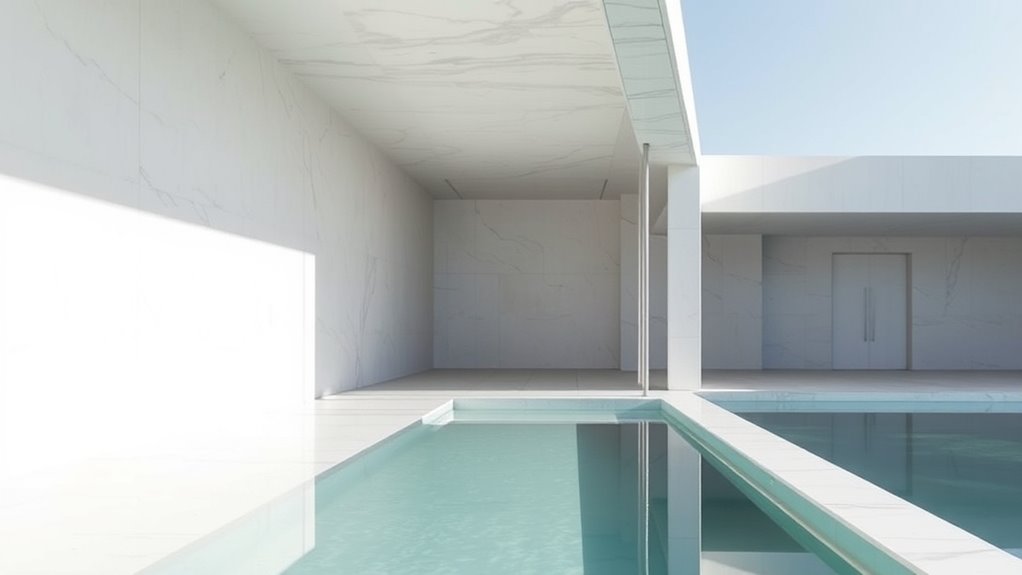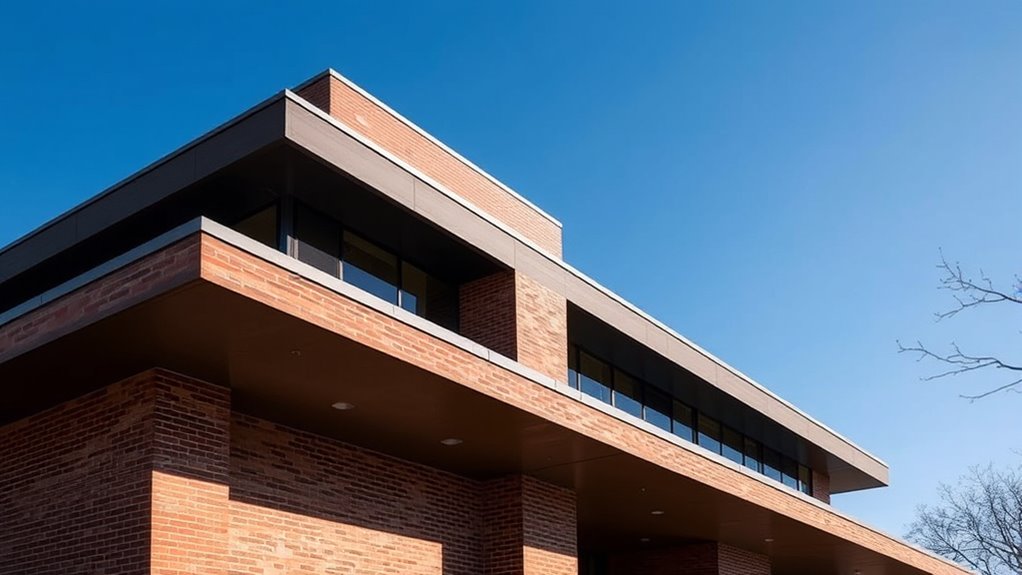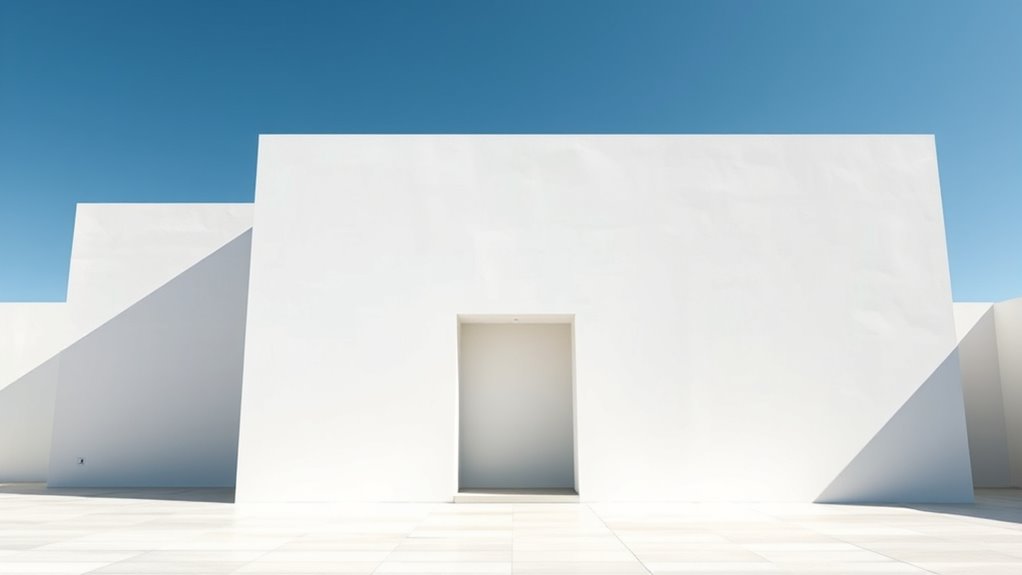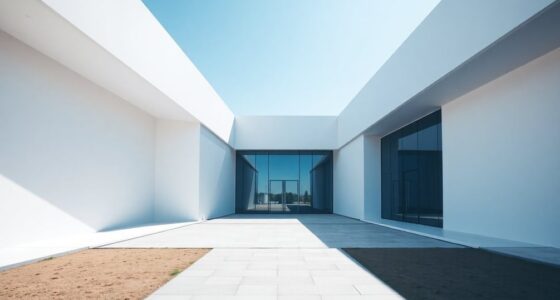To understand minimalism in architecture, look at iconic buildings like the Farnsworth House, which emphasizes open space and natural light through glass walls. The Barcelona Pavilion demonstrates refined materials and balanced composition, creating serenity. The Robie House shows strength with horizontal lines and durable materials. The Glass House blurs inside-out boundaries, focusing on transparency and simple forms. The Maison de Verre combines innovative transparency with function. Keep exploring these designs for timeless lessons in simplicity and purpose.
Key Takeaways
- Emphasize simplicity by removing unnecessary elements, as seen in the minimalist lines of the Farnsworth House.
- Use refined materials and neutral palettes to evoke serenity, exemplified by the Barcelona Pavilion.
- Focus on openness and harmony through material choices like brick and concrete, as in the Robie House.
- Prioritize transparency and geometric purity with expansive glass walls, demonstrated by the Glass House.
- Incorporate innovative, sustainable technologies to enhance function and honesty, as in the Maison de Verre.
The Serene Simplicity of the Farnsworth House

The Farnsworth House exemplifies the essence of minimalist architecture through its clean lines and open design. As you step inside, you notice how the interior aesthetics emphasize simplicity, creating a calming atmosphere.
The use of glass walls blurs the boundaries between interior and exterior, inviting natural light and fostering a sense of openness. Material textures play a vital role, with smooth wood floors and sleek steel supports contributing to the understated elegance. Additionally, the choice of minimalist design principles ensures that every element serves a purpose without unnecessary decoration.
You feel the harmony in the restrained palette and uncluttered space, which encourages a focus on form and function. Every element is intentionally minimal, avoiding excess to highlight the beauty of essential design. Additionally, the contrast ratio in the design ensures that the subtle differences in light and shadow enhance the overall visual harmony.
This approach results in an environment that feels both serene and thoughtfully crafted, embodying the core principles of minimalist architecture.
The Elegant Minimalism of the Barcelona Pavilion

The Barcelona Pavilion exemplifies minimalist elegance through its finely balanced composition and refined use of materials. Its subtle color palette, dominated by neutral tones like white, cream, and soft beige, creates a calm, harmonious atmosphere. These subdued hues highlight the purity of form and emphasize spatial relationships. Material textures play a vital role; sleek marble floors contrast with the smooth, translucent glass walls, while the polished stone surfaces add depth and richness. You notice how the interplay of textures and colors enhances the pavilion’s simplicity without overwhelming it. Every element is carefully curated to evoke a sense of serenity and clarity. This thoughtful combination of color palettes and material textures exemplifies minimalism’s power to create striking, elegant spaces with restraint and sophistication. Additionally, the use of natural light is carefully considered, further enhancing the minimalist aesthetic and emphasizing the spatial qualities of the design. Recognizing how natural lighting influences the perception of space is a key aspect of minimalist architecture, fostering an environment that feels open and inviting. Moreover, understanding the relationship between space and form helps architects craft environments that promote tranquility and focus.
The Monolithic Presence of the Robie House

Although the Robie House embodies a sense of openness and harmony, its design also conveys a powerful monolithic presence. This strength stems from deliberate material choices and structural integrity. The house’s horizontal lines, reinforced by sturdy beams and cantilevered roofs, create a solid, grounded impression. Its materials—rich brick and reinforced concrete—enhance durability and visual weight. The structural stability of these materials ensures resilience over time, even in adverse conditions. The selection of building materials plays a crucial role in achieving both aesthetic minimalism and structural robustness. Incorporating sustainable materials can further improve longevity and environmental performance. Additionally, careful consideration of the material properties helps optimize the balance between form and function. The following table illustrates these features:
| Material | Effect |
|---|---|
| Brick | Adds warmth, solidity, and permanence |
| Reinforced Concrete | Ensures structural integrity and strength |
| Wood | Provides subtle contrast and texture |
| Steel | Supports cantilevered elements |
This combination forms a monumental, cohesive form that commands attention while maintaining minimalist elegance. Cybersecurity vulnerabilities during the design process highlight the importance of considering structural resilience alongside aesthetic minimalism.
The Pure Forms of the Glass House

What makes the Glass House a quintessential example of minimalism? Its design emphasizes interior transparency, blurring the line between inside and outside. By using expansive glass walls, the house creates a sense of openness and fluidity, inviting natural light to flood every space. This approach reflects an understanding of how biodiversity can be integrated into architecture, promoting harmony between built environments and nature. Structural clarity is at the core of its form—each element is simple, honest, and free of unnecessary ornamentation. The clean lines and geometric shapes highlight the pure forms that define the building’s aesthetic. This minimal approach strips architecture down to its essentials, focusing on functionality and material honesty. The use of sustainable materials further emphasizes the commitment to environmental harmony, aligning with minimalist principles. Additionally, appreciating the geometric precision in its design reveals how fundamental shapes and proportional relationships contribute to its aesthetic appeal. As a result, the Glass House embodies the minimalist principle that simplicity enhances beauty and experience, allowing you to appreciate the purity of form and structure without distraction.
The Timeless Design of the Maison De Verre

Nestled at the intersection of innovation and simplicity, the Maison de Verre exemplifies minimalist design that has stood the test of time. Its interior integration creates a seamless flow between spaces, emphasizing function and clarity. The use of material honesty in its construction underscores the authenticity and integrity of its design choices. You’ll notice how the transparency and open layout foster a sense of connection, making every element purposeful. The building’s material honesty shines through in its exposed steel framework, glass walls, and minimalist fixtures, showcasing honesty in construction and design choices. This transparency not only highlights the building’s structural logic but also embraces the truth of its materials. Additionally, the strategic use of natural light enhances the minimalist aesthetic and highlights the structural elements, reinforcing the building’s honest design. Incorporating sustainable practices in its construction demonstrates how eco-friendly methods can align with minimalist principles without compromising aesthetic appeal. The Maison de Verre’s timeless appeal lies in its ability to balance form and function, proving that honest materials and thoughtful interior integration can create a lasting, elegant design. Furthermore, automation technologies employed in its construction demonstrate how innovative methods can complement minimalist principles.
Frequently Asked Questions
How Does Minimalism Influence Environmental Sustainability in Architecture?
Minimalism in architecture influences environmental sustainability by encouraging the use of eco-friendly materials and designing for energy efficiency.
You can reduce waste and minimize resource consumption by choosing sustainable options and simplifying structures.
This approach promotes less construction material, lower energy demands, and a smaller carbon footprint, making your buildings more eco-conscious.
Embracing minimalism helps you create functional, beautiful spaces that are better for the environment and future generations.
What Cultural Factors Shape Minimalist Design Choices Across Different Regions?
Think of architecture as a mirror reflecting regional identities. You see, cultural symbolism and regional aesthetics heavily influence minimalist design choices across different regions.
In Japan, simplicity echoes Zen philosophies, while in Scandinavia, clean lines celebrate functionality and nature. These cultural factors act as the heartbeat of minimalist architecture, guiding designers to honor local traditions and values, shaping spaces that resonate deeply with their community’s unique identity.
How Do Minimalist Buildings Impact the Mental Well-Being of Occupants?
You might find that minimalist buildings foster mindful spaces, which help you achieve mental clarity. Their clean lines and uncluttered environments reduce distractions, allowing you to focus and relax.
By emphasizing simplicity, these spaces promote calmness and reduce stress, positively impacting your mental well-being. When you occupy such environments, you often notice increased tranquility and better emotional balance.
Making minimalist architecture a powerful tool for supporting mental health.
Can Minimalism Be Adapted for Luxury or High-End Residential Design?
Imagine a jewel’s clarity—luxury simplicity, high-end elegance—crafted through minimalist design.
You can adapt minimalism for luxury homes by emphasizing clean lines, refined materials, and open spaces that breathe sophistication.
This approach elevates high-end residences, creating serene, timeless environments.
You’ll find that less truly becomes more, as minimalist principles highlight your home’s beauty and comfort, transforming it into a sanctuary of understated elegance and refined simplicity.
What Are Common Structural Challenges in Constructing Minimalist Architecture?
When constructing minimalist architecture, you often face structural challenges like relying heavily on load-bearing walls, which can limit open space and flexible design.
Material limitations also pose issues, as minimalism demands sleek, clean lines often requiring precise, durable materials.
You need to balance aesthetics with structural integrity, ensuring that simple forms are supported effectively without compromising the minimalist vision.
Careful planning helps overcome these common challenges.
Conclusion
By embracing minimalism, you discover that less truly is more—like the Farnsworth House’s quiet harmony or the Glass House’s transparent honesty. Think of it as sculpting a masterpiece from a single block of marble, revealing beauty through simplicity. When you strip away the unnecessary, you allow space for authenticity and clarity to shine. Minimalism in architecture isn’t just about design; it’s about creating a sanctuary where every element tells a meaningful story.









